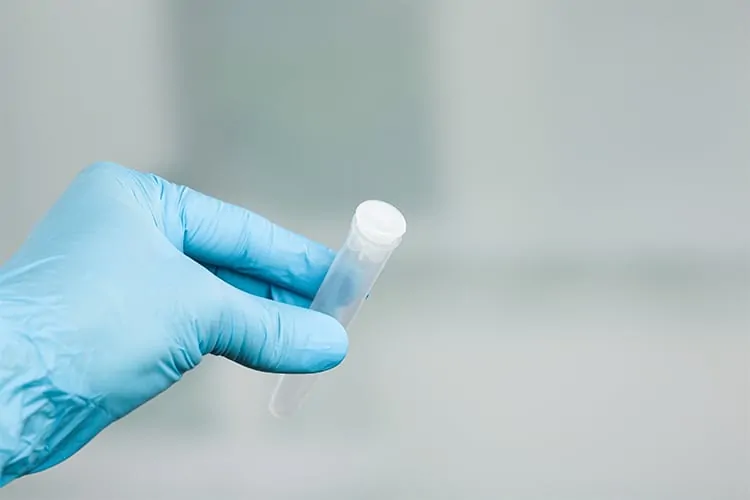Do you want to know more about how a semen analysis is performed, what the scientist look at, and how a semen sample is produced? In this article you will learn how scientists look at the concentration of sperm, sperm movement, and sperm appearances.
What is a Semen Analysis?
A standard semen analysis is performed in a special lab by trained scientists and is a combination of an inspection of the sample with the naked eye, followed by an assessment of it under a microscope.
Why is a semen analysis carried out?
A semen analysis is carried out to roughly estimate a man’s fertility. This is done by comparing certain aspects of it to semen analysis results from a large group of men who fathered children. This is called comparing it to the normal range. If your result are normal, (i.e. the sperm concentration, sperm movement and sperm appearances are within the normal range) it doesn’t automatically mean that you will become a biological parent; also, if the result is slightly lower than normal, it doesn’t mean that you won’t. But it does help us understand when there might be a fertility issues and hopefully, find solutions to help.
How is a semen analysis carried out? What does the scientist look at?
A semen sample consists of both fluid and sperm cells, called spermatozoa. Sometimes other cells may be present, such as cells that might suggest an on-going infection. A semen analysis looks at both of these things in the sample.
A fresh semen sample (one ideally produced less than an hour ago) is delivered to the lab in a pot/container with a lid and the analysis starts straight away. A trained scientist assesses the colour and appearance of the sample and weighs it to estimate the amount. The sample is then left to become more watery (liquefy) for around 30 minutes before its viscosity (how thick or thin it is) is checked. A drop of the semen sample is then placed on a special glass slide to be looked at under a microscope, or it is placed in a counting chamber where a computer will do the same thing (computer-assisted semen analysis or CASA). The first thing looked for are cells that shouldn’t be there, like blood cells or bacteria, and sperm cells that are stuck together (clumping).

If there are a lot of sperm seen, the lab may need to dilute the sample down so that it can be examined more accurately. The sperm cells are then counted and the concentration (numbers of sperm per millilitre) and total sperm count (the number of sperm estimated to be in the whole sample) are calculated.
The scientist then looks at how well the sperm is moving. This is called assessing sperm motility. Sperms that are swimming well in a roughly straight line have what is described as Progressive Motility. Poor moving sperm are Non-progressive. Sperm that isn’t moving is Immotile and some of these sperms will be dead or dying. There is a varying proportion of each of these types in any given sperm sample and the scientist will estimate what the percentages are.
Another aspect that is checked is the sperm appearances. If the sperm have perfect appearances, they are described as having Normal Morphology. Even in a very good sample, the overwhelming number of sperms in the sample will not have normal appearances. The scientist will record the percentage of sperms that have a normal morphology. Some experts argue that morphology is perhaps less important than the number of moving sperms in the sample that are moving well.
Sperm quality can vary greatly in an individual, even on a day to day basis and it is therefore important that if a problem is found, more samples are tested to see if it is a constant issue or not.
What is sperm quality?
In general, the greater the number of normal-looking sperm cells with good motility that are present, the greater the chances of the ability to fertilise an egg. A normal sperm count is more than 15 million sperm cells per millilitre. It is also generally accepted that for sperm to be considered of good quality, more than 40% of the sperm cells must be living and moving. Also, in a normal sperm sample, more than 4% of the sperms should be of a normal appearance.
Semen quality depends on many different factors, such as sperm production by the testis, the testis size, the amount of fluid produced by glands in the male genital tract, recent illness, the time since the man last ejaculated and the way in which the sample is collected. All aspects of semen collection and analysis must be done by properly if the results are to provide valid, useful information. The scientists therefore spend a lot of time making sure that the equipment is working properly and that they are getting the right results.

How to produce a semen sample
For most men sperm cells are constantly produced in the testicles, however it usually takes around two days to generate a new portion of sperm cells after an ejaculation, hence semen samples produced after two days of abstinence usually have the highest number of motile sperm cells compared to both semen samples after shorter and longer abstinence periods. After shorter time of abstinence there is a smaller amount of sperm cells, but the motility will probably be good. After longer time of abstinence, the sperm cells will start to degenerate. There may be a greater number of sperm cells, but they will start to have reduced motility. Therefore, to get the most reliable test of your sperm, testing is best done on an ejaculation produced after 2-3 days of abstinence as this will most often give the best balance between motility and count. This means that it is recommended to have no sex or no ejaculation of any kind, including masturbation for 2-3 days prior to a semen sample test.
The sample should ideally be produced at the clinic/sperm bank, so that it can be analysed straight away. If this isn’t possible then the lab will tell you how to bring in a sample that you can produce at home. Hand washing and washing of the penis are the first steps to lower the chance of the sample being contaminated with bacteria. Lubricants shouldn’t be used as most of them contain substances that can kill sperm cells and so may harm your sample, affecting the result. Semen samples are to be produced by masturbation and collected in a clean pot/container with a lid. It is important that you collect the entire ejaculate, especially the first drops, but do not attempt to collect any spilled semen. Sperm cells do not live long in the pot, so make sure you deliver it for examination straight away. Delays in delivering the semen sample and exposure to high or low temperatures will result in inaccurate results. Make sure your name, date of birth and the time and date of your sample is clearly written on the cup.
Summary
Semen analysis is an important test that can show if there is a problem with male fertility. The sample is carefully examined in a laboratory. In particular, they look at the concentration of sperm, sperm movement and sperm appearances. Lots of things can affect the result and it is very important to follow the instructions that the lab gives you, to get the most accurate result. If the result is not so good, it will need to be repeated at least once.
You can read more about sperm testing methods, like ASAB, sperm viability, or DNA fragmentation in this article.



